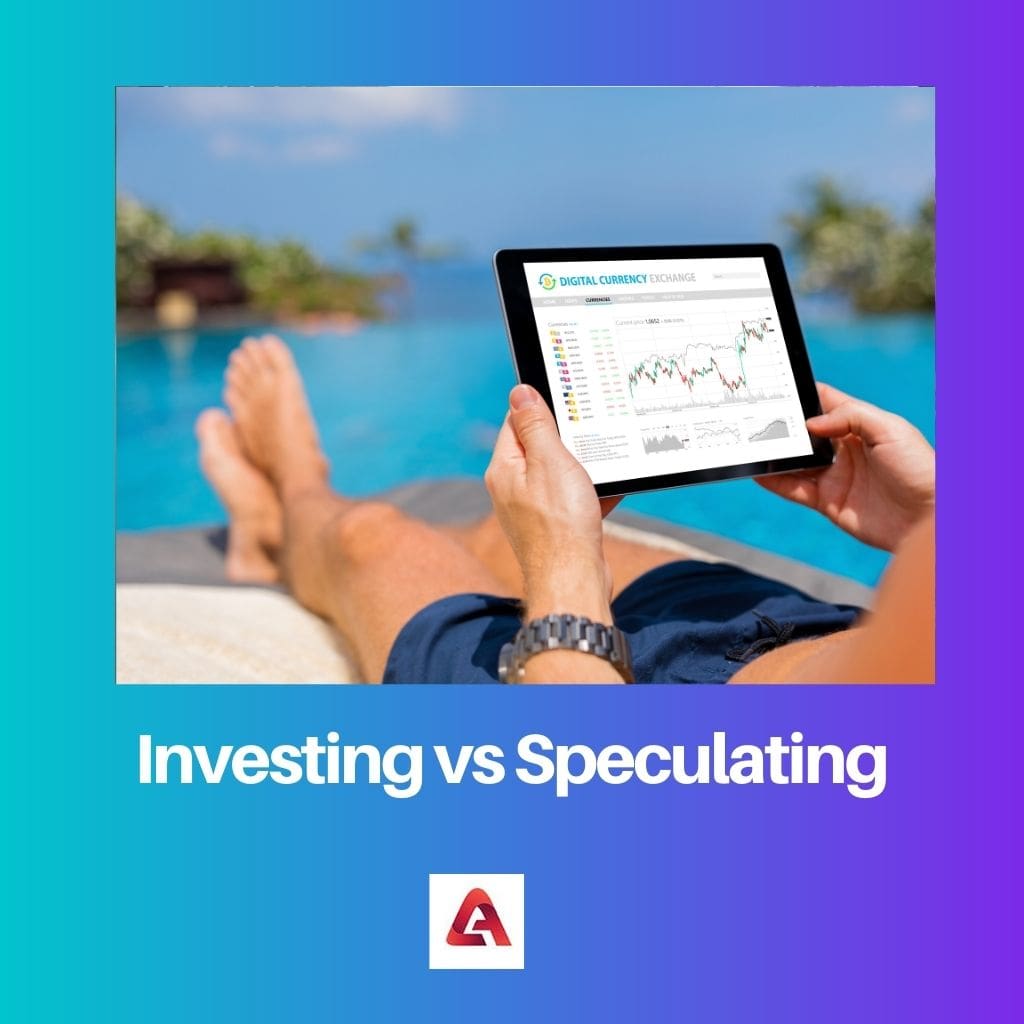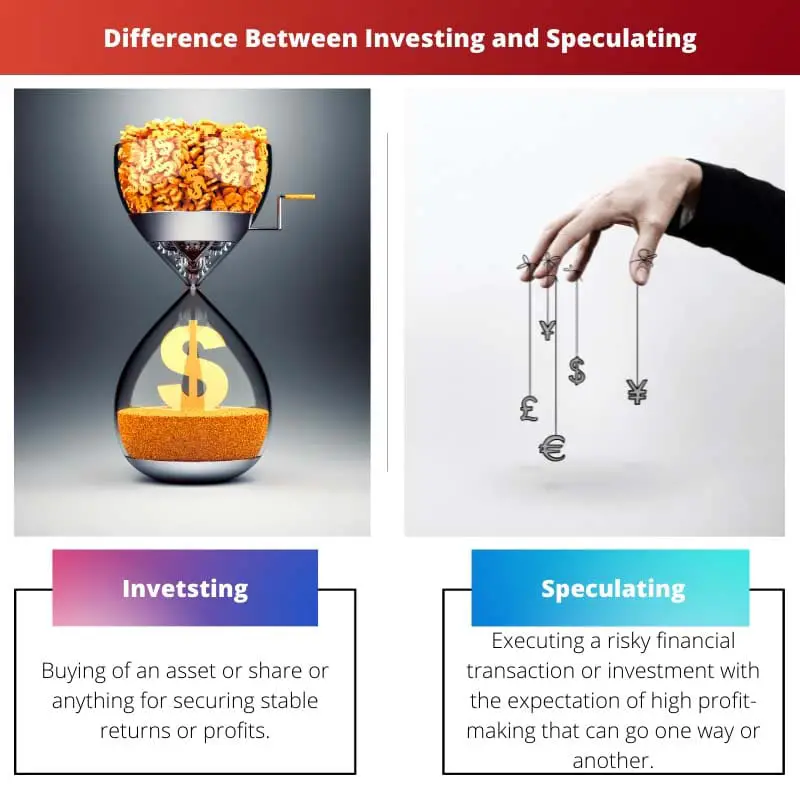Investing involves deploying capital into assets with the expectation of generating returns over time through fundamental analysis, strategic planning, and a focus on long-term growth or income. Speculating, however, entails taking higher risks, driven by short-term market trends or speculation on price movements, with less emphasis on underlying asset value and more on potential quick profits, making it inherently more volatile and speculative in nature.
Key Takeaways
- Investing involves acquiring assets expecting long-term growth or income while speculating focuses on short-term price fluctuations to achieve rapid gains.
- Investing relies on careful analysis, research, and risk management, whereas speculating involves higher risks and less information.
- Examples of investing include purchasing stocks, bonds, or real estate while speculating might involve day trading, options trading, or betting on market trends.
Investing vs Speculating
The difference between investing and speculating is about risk factors or the level of risk taken during investing or speculating. The story of risk and the probability of failure is low in investing. At the same time, the level of risk and likelihood of failure is too high in speculating.

Comparison Table
| Feature | Investing | Speculating |
|---|---|---|
| Objective | Grow wealth over the long term | Achieve high returns quickly |
| Risk Level | Lower, aiming for moderate and consistent returns | Higher, accepting potential for significant losses |
| Time Horizon | Long-term (years or decades) | Short-term (days, weeks, or months) |
| Focus | Underlying value of assets and fundamentals | Price movements and technical analysis |
| Investment Type | Stocks, bonds, mutual funds, ETFs | Options, futures, penny stocks, highly volatile assets |
| Approach | Research, diversification, buy-and-hold strategy | Active trading, market timing, potentially leveraged positions |
| Example | Investing in a diversified portfolio of blue-chip stocks | Trading cryptocurrency based on short-term price movements |
What is Investing?
Investing refers to the strategic deployment of financial resources into various assets or ventures with the expectation of generating profitable returns over time. It involves committing capital with the aim of preserving and growing it, over the long term. Unlike saving, which involves placing funds in low-risk instruments such as savings accounts or CDs, investing entails assuming some level of risk in pursuit of higher potential rewards.
Objectives of Investing
Investing serves multiple objectives, including wealth accumulation, retirement planning, funding education, and achieving financial goals. By allocating resources across different asset classes such as stocks, bonds, real estate, and commodities, investors aim to build a diversified portfolio capable of weathering market fluctuations and achieving desired outcomes.
Principles of Investing
- Risk and Return: Investing involves balancing risk and return. Generally, higher returns are associated with higher risk, so investors must assess their risk tolerance and investment horizon before selecting appropriate assets.
- Diversification: Spreading investments across different asset classes and sectors can help mitigate risk. Diversification aims to reduce portfolio volatility by not relying too heavily on any single investment.
- Time Horizon: The length of time an investor intends to hold an investment influences the selection of assets. Longer time horizons allow for more aggressive investment strategies, while shorter horizons may necessitate more conservative approaches.
- Research and Analysis: Informed decision-making is crucial in investing. Conducting thorough research, analyzing financial data, and understanding market trends can help investors identify opportunities and make educated investment choices.
Types of Investments
Investors can choose from a wide range of investment options, including:
- Stocks: Ownership stakes in publicly traded companies, offering potential capital appreciation and dividends.
- Bonds: Debt securities issued by governments or corporations, providing fixed income payments and principal repayment at maturity.
- Real Estate: Physical properties or real estate investment trusts (REITs) that generate rental income and potential appreciation.
- Mutual Funds and ETFs: Pooled funds managed by professionals, providing diversification across various assets.
- Commodities: Physical goods such as gold, oil, or agricultural products, offering diversification and a hedge against inflation.

What is Speculating?
Speculating involves engaging in financial transactions with the primary goal of profiting from short-term price fluctuations or market inefficiencies. Unlike investing, which focuses on long-term growth and income generation through fundamental analysis, speculating relies on technical analysis, market sentiment, and timing to capitalize on volatile price movements. Speculators have a shorter investment horizon and are willing to take on higher levels of risk in pursuit of quick profits.
Characteristics of Speculating
- Short-Term Orientation: Speculators are primarily concerned with short-term price movements rather than the underlying value of assets. They may buy or sell assets with the intention of profiting from price changes within days, hours, or even minutes.
- High Risk, High Reward: Speculating inherently involves higher levels of risk compared to investing. While the potential for significant gains exists, speculators also face the risk of substantial losses, especially if their predictions or timing are incorrect.
- Lack of Fundamental Analysis: Unlike investors who conduct thorough research and analysis of company fundamentals, speculators rely on technical indicators, market trends, and momentum trading strategies to make trading decisions.
- Market Timing: Successful speculation requires precise market timing. Speculators attempt to anticipate short-term price movements based on factors such as news events, market sentiment, and technical patterns.
Types of Speculative Strategies
- Day Trading: Speculators engage in the buying and selling of financial instruments within the same trading day, aiming to capitalize on intraday price fluctuations.
- Swing Trading: Speculators hold positions for several days or weeks to profit from short-to-medium-term price trends.
- Options and Futures Trading: Speculators use derivatives such as options and futures contracts to leverage their bets on the future price movements of underlying assets.
- Forex Trading: Speculators trade currencies in the foreign exchange market, attempting to profit from fluctuations in exchange rates.
Risks and Considerations
- Volatility: Speculative markets can be highly volatile, increasing the potential for rapid price swings and unexpected losses.
- Leverage: Speculators use leverage to amplify their potential returns, but this also magnifies the impact of losses, leading to significant risks.
- Lack of Control: Speculative outcomes are influenced by numerous factors beyond the speculator’s control, including macroeconomic events, geopolitical developments, and market sentiment.

Main Differences Between Investing and Speculating
- Time Horizon:
- Investing: Typically involves a longer time horizon, aiming for gradual wealth accumulation and income generation over the years.
- Speculating: Often characterized by a shorter time horizon, focusing on capitalizing on short-term price fluctuations for quick profits.
- Risk Management:
- Investing: Emphasizes risk management through diversification, fundamental analysis, and a focus on the underlying value of assets.
- Speculating: Involves higher levels of risk, relying on market timing, technical analysis, and leverage to maximize potential returns.
- Objective:
- Investing: Aimed at achieving long-term financial goals, such as retirement planning, wealth preservation, and funding education.
- Speculating: Primarily driven by the desire for short-term gains, with less emphasis on long-term financial planning and more focus on exploiting market volatility.
- Approach to Analysis:
- Investing: Relies on fundamental analysis, evaluating the financial health, growth prospects, and valuation of companies or assets.
- Speculating: Often involves technical analysis, focusing on market trends, chart patterns, and momentum to forecast short-term price movements.
- Mindset:
- Investing: Requires patience, discipline, and a long-term perspective, with an understanding of the importance of time in wealth accumulation.
- Speculating: Tends to attract individuals seeking excitement, quick profits, and adrenaline-driven trading, sometimes resembling gambling more than strategic wealth-building.




